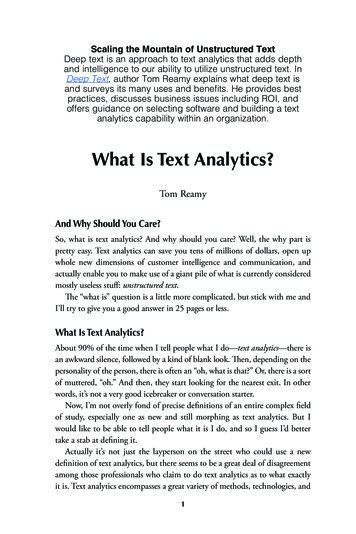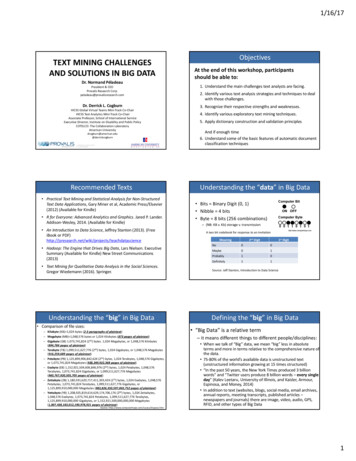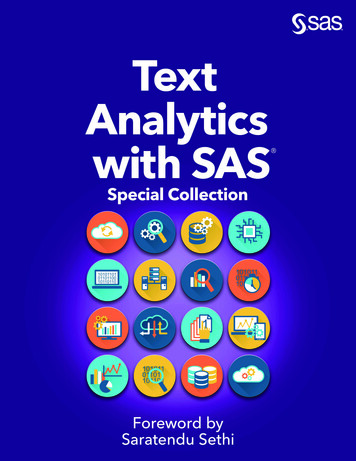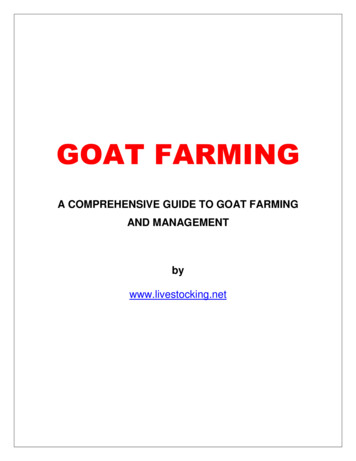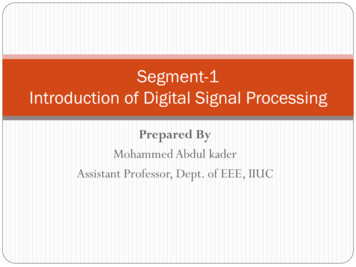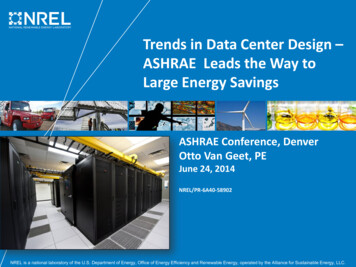
Transcription
iData-Intensive Text Processingwith MapReduceJimmy Lin and Chris DyerUniversity of Maryland, College ParkManuscript prepared April 11, 2010This is the pre-production manuscript of a book in the Morgan & Claypool SynthesisLectures on Human Language Technologies. Anticipated publication date is mid-2010.
iiContentsContents . . . . . . . . . . . . . . . . . . . . . . . . . . . . . . . . . . . . . . . . . . . . . . . . . . . . . . . . . . . . . . . . . . . . . ii123Introduction . . . . . . . . . . . . . . . . . . . . . . . . . . . . . . . . . . . . . . . . . . . . . . . . . . . . . . . . . . . . . . . . . 11.1Computing in the Clouds. . . . . . . . . . . . . . . . . . . . . . . . . . . . . . . . . . . . . . . . . . . . . . .61.2Big Ideas. . . . . . . . . . . . . . . . . . . . . . . . . . . . . . . . . . . . . . . . . . . . . . . . . . . . . . . . . . . . . . .91.3Why Is This Different? . . . . . . . . . . . . . . . . . . . . . . . . . . . . . . . . . . . . . . . . . . . . . . . . 151.4What This Book Is Not . . . . . . . . . . . . . . . . . . . . . . . . . . . . . . . . . . . . . . . . . . . . . . . 17MapReduce Basics . . . . . . . . . . . . . . . . . . . . . . . . . . . . . . . . . . . . . . . . . . . . . . . . . . . . . . . . . . 182.1Functional Programming Roots . . . . . . . . . . . . . . . . . . . . . . . . . . . . . . . . . . . . . . . 202.2Mappers and Reducers . . . . . . . . . . . . . . . . . . . . . . . . . . . . . . . . . . . . . . . . . . . . . . . . 222.3The Execution Framework . . . . . . . . . . . . . . . . . . . . . . . . . . . . . . . . . . . . . . . . . . . . 262.4Partitioners and Combiners . . . . . . . . . . . . . . . . . . . . . . . . . . . . . . . . . . . . . . . . . . . 282.5The Distributed File System . . . . . . . . . . . . . . . . . . . . . . . . . . . . . . . . . . . . . . . . . . 312.6Hadoop Cluster Architecture . . . . . . . . . . . . . . . . . . . . . . . . . . . . . . . . . . . . . . . . . . 362.7Summary . . . . . . . . . . . . . . . . . . . . . . . . . . . . . . . . . . . . . . . . . . . . . . . . . . . . . . . . . . . . . 38MapReduce Algorithm Design . . . . . . . . . . . . . . . . . . . . . . . . . . . . . . . . . . . . . . . . . . . . . . . 393.1Local Aggregation . . . . . . . . . . . . . . . . . . . . . . . . . . . . . . . . . . . . . . . . . . . . . . . . . . . . 413.1.1 Combiners and In-Mapper Combining413.1.2 Algorithmic Correctness with Local Aggregation463.2Pairs and Stripes . . . . . . . . . . . . . . . . . . . . . . . . . . . . . . . . . . . . . . . . . . . . . . . . . . . . . . 503.3Computing Relative Frequencies . . . . . . . . . . . . . . . . . . . . . . . . . . . . . . . . . . . . . . 573.4Secondary Sorting. . . . . . . . . . . . . . . . . . . . . . . . . . . . . . . . . . . . . . . . . . . . . . . . . . . . .603.5Relational Joins . . . . . . . . . . . . . . . . . . . . . . . . . . . . . . . . . . . . . . . . . . . . . . . . . . . . . . . 623.5.1 Reduce-Side Join3.5.2 Map-Side Join64663.5.3 Memory-Backed Join67
CONTENTS3.64Summary . . . . . . . . . . . . . . . . . . . . . . . . . . . . . . . . . . . . . . . . . . . . . . . . . . . . . . . . . . . . . 68Inverted Indexing for Text Retrieval . . . . . . . . . . . . . . . . . . . . . . . . . . . . . . . . . . . . . . . . . 704.1Web Crawling . . . . . . . . . . . . . . . . . . . . . . . . . . . . . . . . . . . . . . . . . . . . . . . . . . . . . . . . . 714.2Inverted Indexes . . . . . . . . . . . . . . . . . . . . . . . . . . . . . . . . . . . . . . . . . . . . . . . . . . . . . . 734.3Inverted Indexing: Baseline Implementation . . . . . . . . . . . . . . . . . . . . . . . . . . . 754.4Inverted Indexing: Revised Implementation . . . . . . . . . . . . . . . . . . . . . . . . . . . . 774.5Index Compression . . . . . . . . . . . . . . . . . . . . . . . . . . . . . . . . . . . . . . . . . . . . . . . . . . . . 794.5.1 Byte-Aligned and Word-Aligned Codes4.5.2 Bit-Aligned Codes680824.5.3 Postings Compression5iii844.6What About Retrieval? . . . . . . . . . . . . . . . . . . . . . . . . . . . . . . . . . . . . . . . . . . . . . . . 864.7Summary and Additional Readings . . . . . . . . . . . . . . . . . . . . . . . . . . . . . . . . . . . . 89Graph Algorithms. . . . . . . . . . . . . . . . . . . . . . . . . . . . . . . . . . . . . . . . . . . . . . . . . . . . . . . . . . .915.1Graph Representations . . . . . . . . . . . . . . . . . . . . . . . . . . . . . . . . . . . . . . . . . . . . . . . . 935.2Parallel Breadth-First Search. . . . . . . . . . . . . . . . . . . . . . . . . . . . . . . . . . . . . . . . . .945.3PageRank. . . . . . . . . . . . . . . . . . . . . . . . . . . . . . . . . . . . . . . . . . . . . . . . . . . . . . . . . . . .1025.4Issues with Graph Processing . . . . . . . . . . . . . . . . . . . . . . . . . . . . . . . . . . . . . . . . 1085.5Summary and Additional Readings. . . . . . . . . . . . . . . . . . . . . . . . . . . . . . . . . . .110EM Algorithms for Text Processing . . . . . . . . . . . . . . . . . . . . . . . . . . . . . . . . . . . . . . . . 1126.1Expectation Maximization . . . . . . . . . . . . . . . . . . . . . . . . . . . . . . . . . . . . . . . . . . . 1156.1.1 Maximum Likelihood Estimation1156.1.2 A Latent Variable Marble Game1176.1.3 MLE with Latent Variables1186.1.4 Expectation Maximization6.1.5 An EM Example6.2119120Hidden Markov Models . . . . . . . . . . . . . . . . . . . . . . . . . . . . . . . . . . . . . . . . . . . . . . 1216.2.1 Three Questions for Hidden Markov Models6.2.2 The Forward Algorithm6.2.3 The Viterbi Algorithm125126123
ivCONTENTS6.2.4 Parameter Estimation for HMMs1296.2.5 Forward-Backward Training: Summary6.3EM in MapReduce . . . . . . . . . . . . . . . . . . . . . . . . . . . . . . . . . . . . . . . . . . . . . . . . . . . 1346.3.1 HMM Training in MapReduce6.4133135Case Study: Word Alignment for Statistical Machine Translation . . . . . 1386.4.1 Statistical Phrase-Based Translation1396.4.2 Brief Digression: Language Modeling with MapReduce6.4.3 Word Alignment6.4.4 Experiments6.5143144EM-Like Algorithms . . . . . . . . . . . . . . . . . . . . . . . . . . . . . . . . . . . . . . . . . . . . . . . . . 1476.5.1 Gradient-Based Optimization and Log-Linear Models6.67142147Summary and Additional Readings. . . . . . . . . . . . . . . . . . . . . . . . . . . . . . . . . . .150Closing Remarks . . . . . . . . . . . . . . . . . . . . . . . . . . . . . . . . . . . . . . . . . . . . . . . . . . . . . . . . . . . 1527.1Limitations of MapReduce . . . . . . . . . . . . . . . . . . . . . . . . . . . . . . . . . . . . . . . . . . . 1527.2Alternative Computing Paradigms . . . . . . . . . . . . . . . . . . . . . . . . . . . . . . . . . . . 1547.3MapReduce and Beyond . . . . . . . . . . . . . . . . . . . . . . . . . . . . . . . . . . . . . . . . . . . . . 156
1CHAPTER1IntroductionMapReduce [45] is a programming model for expressing distributed computations onmassive amounts of data and an execution framework for large-scale data processingon clusters of commodity servers. It was originally developed by Google and built onwell-known principles in parallel and distributed processing dating back several decades.MapReduce has since enjoyed widespread adoption via an open-source implementationcalled Hadoop, whose development was led by Yahoo (now an Apache project). Today,a vibrant software ecosystem has sprung up around Hadoop, with significant activityin both industry and academia.This book is about scalable approaches to processing large amounts of text withMapReduce. Given this focus, it makes sense to start with the most basic question:Why? There are many answers to this question, but we focus on two. First, “big data”is a fact of the world, and therefore an issue that real-world systems must grapple with.Second, across a wide range of text processing applications, more data translates intomore effective algorithms, and thus it makes sense to take advantage of the plentifulamounts of data that surround us.Modern information societies are defined by vast repositories of data, both publicand private. Therefore, any practical application must be able to scale up to datasetsof interest. For many, this means scaling up to the web, or at least a non-trivial fraction thereof. Any organization built around gathering, analyzing, monitoring, filtering,searching, or organizing web content must tackle large-data problems: “web-scale” processing is practically synonymous with data-intensive processing. This observation applies not only to well-established internet companies, but also countless startups andniche players as well. Just think, how many companies do you know that start theirpitch with “we’re going to harvest information on the web and. . . ”?Another strong area of growth is the analysis of user behavior data. Any operatorof a moderately successful website can record user activity and in a matter of weeks (orsooner) be drowning in a torrent of log data. In fact, logging user behavior generatesso much data that many organizations simply can’t cope with the volume, and eitherturn the functionality off or throw away data after some time. This represents lostopportunities, as there is a broadly-held belief that great value lies in insights derivedfrom mining such data. Knowing what users look at, what they click on, how muchtime they spend on a web page, etc. leads to better business decisions and competitiveadvantages. Broadly, this is known as business intelligence, which encompasses a widerange of technologies including data warehousing, data mining, and analytics.
2CHAPTER 1. INTRODUCTIONHow much data are we talking about? A few examples: Google grew from processing 100 TB of data a day with MapReduce in 2004 [45] to processing 20 PB a daywith MapReduce in 2008 [46]. In April 2009, a blog post1 was written about eBay’stwo enormous data warehouses: one with 2 petabytes of user data, and the other with6.5 petabytes of user data spanning 170 trillion records and growing by 150 billion newrecords per day. Shortly thereafter, Facebook revealed2 similarly impressive numbers,boasting of 2.5 petabytes of user data, growing at about 15 terabytes per day. Petabytedatasets are rapidly becoming the norm, and the trends are clear: our ability to storedata is fast overwhelming our ability to process what we store. More distressing, increases in capacity are outpacing improvements in bandwidth such that our ability toeven read back what we store is deteriorating [91]. Disk capacities have grown from tensof megabytes in the mid-1980s to about a couple of terabytes today (several orders ofmagnitude). On the other hand, latency and bandwidth have improved relatively little:in the case of latency, perhaps 2 improvement during the last quarter century, andin the case of bandwidth, perhaps 50 . Given the tendency for individuals and organizations to continuously fill up whatever capacity is available, large-data problems aregrowing increasingly severe.Moving beyond the commercial sphere, many have recognized the importance ofdata management in many scientific disciplines, where petabyte-scale datasets are alsobecoming increasingly common [21]. For example: The high-energy physics community was already describing experiences withpetabyte-scale databases back in 2005 [20]. Today, the Large Hadron Collider(LHC) near Geneva is the world’s largest particle accelerator, designed to probethe mysteries of the universe, including the fundamental nature of matter, byrecreating conditions shortly following the Big Bang. When it becomes fully operational, the LHC will produce roughly 15 petabytes of data a year.3 Astronomers have long recognized the importance of a “digital observatory” thatwould support the data needs of researchers across the globe—the Sloan DigitalSky Survey [145] is perhaps the most well known of these projects. Looking intothe future, the Large Synoptic Survey Telescope (LSST) is a wide-field instrumentthat is capable of observing the entire sky every few days. When the telescopecomes online around 2015 in Chile, its 3.2 gigapixel primary camera will produceapproximately half a petabyte of archive images every month [19]. The advent of next-generation DNA sequencing technology has created a delugeof sequence data that needs to be stored, organized, and delivered to scientists for1 -data-warehouses/2 d-hive/3 en.html
3further study. Given the fundamental tenant in modern genetics that genotypesexplain phenotypes, the impact of this technology is nothing less than transformative [103]. The European Bioinformatics Institute (EBI), which hosts a centralrepository of sequence data called EMBL-bank, has increased storage capacityfrom 2.5 petabytes in 2008 to 5 petabytes in 2009 [142]. Scientists are predictingthat, in the not-so-distant future, sequencing an individual’s genome will be nomore complex than getting a blood test today—ushering a new era of personalizedmedicine, where interventions can be specifically targeted for an individual.Increasingly, scientific breakthroughs will be powered by advanced computing capabilities that help researchers manipulate, explore, and mine massive datasets [72]—thishas been hailed as the emerging “fourth paradigm” of science [73] (complementing theory, experiments, and simulations). In other areas of academia, particularly computerscience, systems and algorithms incapable of scaling to massive real-world datasets runthe danger of being dismissed as “toy systems” with limited utility. Large data is a factof today’s world and data-intensive processing is fast becoming a necessity, not merelya luxury or curiosity.Although large data comes in a variety of forms, this book is primarily concernedwith processing large amounts of text, but touches on other types of data as well (e.g.,relational and graph data). The problems and solutions we discuss mostly fall into thedisciplinary boundaries of natural language processing (NLP) and information retrieval(IR). Recent work in these fields is dominated by a data-driven, empirical approach,typically involving algorithms that attempt to capture statistical regularities in data forthe purposes of some task or application. There are three components to this approach:data, representations of the data, and some method for capturing regularities in thedata. Data are called corpora (singular, corpus) by NLP researchers and collections bythose from the IR community. Aspects of the representations of the data are called features, which may be “superficial” and easy to extract, such as the words and sequencesof words themselves, or “deep” and more difficult to extract, such as the grammaticalrelationship between words. Finally, algorithms or models are applied to capture regularities in the data in terms of the extracted features for some application. One commonapplication, classification, is to sort text into categories. Examples include: Is this emailspam or not spam? Is this word part of an address or a location? The first task iseasy to understand, while the second task is an instance of what NLP researchers callnamed-entity detection [138], which is useful for local search and pinpointing locationson maps. Another common application is to rank texts according to some criteria—search is a good example, which involves ranking documents by relevance to the user’squery. Another example is to automatically situate texts along a scale of “happiness”,a task known as sentiment analysis or opinion mining [118], which has been applied to
4CHAPTER 1. INTRODUCTIONeverything from understanding political discourse in the blogosphere to predicting themovement of stock prices.There is a growing body of evidence, at least in text processing, that of the threecomponents discussed above (data, features, algorithms), data probably matters themost. Superficial word-level features coupled with simple models in most cases trumpsophisticated models over deeper features and less data. But why can’t we have our cakeand eat it too? Why not both sophisticated models and deep features applied to lots ofdata? Because inference over sophisticated models and extraction of deep features areoften computationally intensive, they don’t scale well.Consider a simple task such as determining the correct usage of easily confusablewords such as “than” and “then” in English. One can view this as a supervised machinelearning problem: we can train a classifier to disambiguate between the options, andthen apply the classifier to new instances of the problem (say, as part of a grammarchecker). Training data is fairly easy to come by—we can just gather a large corpus oftexts and assume that most writers make correct choices (the training data may be noisy,since people make mistakes, but no matter). In 2001, Banko and Brill [14] publishedwhat has become a classic paper in natural language processing exploring the effectsof training data size on classification accuracy, using this task as the specific example.They explored several classification algorithms (the exact ones aren’t important, as weshall see), and not surprisingly, found that more data led to better accuracy. Acrossmany different algorithms, the increase in accuracy was approximately linear in thelog of the size of the training data. Furthermore, with increasing amounts of trainingdata, the accuracy of different algorithms converged, such that pronounced differencesin effectiveness observed on smaller datasets basically disappeared at scale. This led toa somewhat controversial conclusion (at least at the time): machine learning algorithmsreally don’t matter, all that matters is the amount of data you have. This resulted inan even more controversial recommendation, delivered somewhat tongue-in-cheek: weshould just give up working on algorithms and simply spend our time gathering data(while waiting for computers to become faster so we can process the data).As another example, consider the problem of answering short, fact-based questionssuch as “Who shot Abraham Lincoln?” Instead of returning a list of documents that theuser would then have to sort through, a question answering (QA) system would directlyreturn the answer: John Wilkes Booth. This problem gained interest in the late 1990s,when natural language processing researchers approached the challenge with sophisticated linguistic processing techniques such as syntactic and semantic analysis. Around2001, researchers discovered a far simpler approach to answering such questions basedon pattern matching [27, 53, 92]. Suppose you wanted the answer to the above question.As it turns out, you can simply search for the phrase “shot Abraham Lincoln” on theweb and look for what appears to its left. Or better yet, look through multiple instances
5of this phrase and tally up the words that appear to the left. This simple strategy workssurprisingly well, and has become known as the redundancy-based approach to questionanswering. It capitalizes on the insight that in a very large text collection (i.e., theweb), answers to commonly-asked questions will be stated in obvious ways, such thatpattern-matching techniques suffice to extract answers accurately.Yet another example concerns smoothing in web-scale language models [25]. Alanguage model is a probability distribution that characterizes the likelihood of observing a particular sequence of words, estimated from a large corpus of texts. They areuseful in a variety of applications, such as speech recognition (to determine what thespeaker is more likely to have said) and machine translation (to determine which ofpossible translations is the most fluent, as we will discuss in Section 6.4). Since thereare infinitely many possible strings, and probabilities must be assigned to all of them,language modeling is a more challenging task than simply keeping track of which stringswere seen how many times: some number of likely strings will never be encountered,even with lots and lots of training data! Most modern language models make the Markovassumption: in a n-gram language model, the conditional probability of a word is givenby the n 1 previous words. Thus, by the chain rule, the probability of a sequence ofwords can be decomposed into the product of n-gram probabilities. Nevertheless, anenormous number of parameters must still be estimated from a training corpus: potentially V n parameters, where V is the number of words in the vocabulary. Even if wetreat every word on the web as the training corpus from which to estimate the n-gramprobabilities, most n-grams—in any language, even English—will never have been seen.To cope with this sparseness, researchers have developed a number of smoothing techniques [35, 102, 79], which all share the basic idea of moving probability mass fromobserved to unseen events in a principled manner. Smoothing approaches vary in effectiveness, both in terms of intrinsic and application-specific metrics. In 2007, Brantset al. [25] described language models trained on up to two trillion words.4 Their experiments compared a state-of-the-art approach known as Kneser-Ney smoothing [35]with another technique the authors affectionately referred to as “stupid backoff”.5 Notsurprisingly, stupid backoff didn’t work as well as Kneser-Ney smoothing on smallercorpora. However, it was simpler and could be trained on more data, which ultimatelyyielded better language models. That is, a simpler technique on more data beat a moresophisticated technique on less data.4 Asan aside, it is interesting to observe the evolving definition of large over the years. Banko and Brill’s paperin 2001 was titled Scaling to Very Very Large Corpora for Natural Language Disambiguation, and dealt witha corpus containing a billion words.5 As in, so stupid it couldn’t possibly work.
6CHAPTER 1. INTRODUCTIONRecently, three Google researchers summarized this data-driven philosophy inan essay titled The Unreasonable Effectiveness of Data [65].6 Why is this so? It boilsdown to the fact that language in the wild, just like human behavior in general, ismessy. Unlike, say, the interaction of subatomic particles, human use of language isnot constrained by succinct, universal “laws of grammar”. There are of course rulesthat govern the formation of words and sentences—for example, that verbs appearbefore objects in English, and that subjects and verbs must agree in number in manylanguages—but real-world language is affected by a multitude of other factors as well:people invent new words and phrases all the time, authors occasionally make mistakes,groups of individuals write within a shared context, etc. The Argentine writer JorgeLuis Borges wrote a famous allegorical one-paragraph story about a fictional societyin which the art of cartography had gotten so advanced that their maps were as bigas the lands they were describing.7 The world, he would say, is the best description ofitself. In the same way, the more observations we gather about language use, the moreaccurate a description we have of language itself. This, in turn, translates into moreeffective algorithms and systems.So, in summary, why large data? In some ways, the first answer is similar tothe reason people climb mountains: because they’re there. But the second answer iseven more compelling. Data represent the rising tide that lifts all boats—more datalead to better algorithms and systems for solving real-world problems. Now that we’veaddressed the why, let’s tackle the how. Let’s start with the obvious observation: dataintensive processing is beyond the capability of any individual machine and requiresclusters—which means that large-data problems are fundamentally about organizingcomputations on dozens, hundreds, or even thousands of machines. This is exactlywhat MapReduce does, and the rest of this book is about the how.1.1COMPUTING IN THE CLOUDSFor better or for worse, it is often difficult to untangled MapReduce and large-dataprocessing from the broader discourse on cloud computing. True, there is substantialpromise in this new paradigm of computing, but unwarranted hype by the media andpopular sources threatens its credibility in the long run. In some ways, cloud computing6 Thistitle was inspired by a classic article titled The Unreasonable Effectiveness of Mathematics in the NaturalSciences [155]. This is somewhat ironic in that the original article lauded the beauty and elegance of mathematical models in capturing natural phenomena, which is the exact opposite of the data-driven approach.7 On Exactitude in Science [23]. A similar exchange appears in Chapter XI of Sylvie and Bruno Concluded byLewis Carroll (1893).
1.1. COMPUTING IN THE CLOUDSis simply brilliant marketing. Before clouds, there were grids, and before grids, therewere vector supercomputers, each having claimed to be the best thing since sliced bread.So what exactly is cloud computing? This is one of those questions where tenexperts will give eleven different answers; in fact, countless papers have been writtensimply to attempt to define the term (e.g., [9, 31, 149], just to name a few examples).Here we offer up our own thoughts and attempt to explain how cloud computing relatesto MapReduce and data-intensive processing.At the most superficial level, everything that used to be called web applications hasbeen rebranded to become “cloud applications”, which includes what we have previouslycalled “Web 2.0” sites. In fact, anything running inside a browser that gathers and storesuser-generated content now qualifies as an example of cloud computing. This includessocial-networking services such as Facebook, video-sharing sites such as YouTube, webbased email services such as Gmail, and applications such as Google Docs. In thiscontext, the cloud simply refers to the servers that power these sites, and user data issaid to reside “in the cloud”. The accumulation of vast quantities of user data createslarge-data problems, many of which are suitable for MapReduce. To give two concreteexamples: a social-networking site analyzes connections in the enormous globe-spanninggraph of friendships to recommend new connections. An online email service analyzesmessages and user behavior to optimize ad selection and placement. These are all largedata problems that have been tackled with MapReduce.9Another important facet of cloud computing is what’s more precisely known asutility computing [129, 31]. As the name implies, the idea behind utility computingis to treat computing resource as a metered service, like electricity or natural gas.The idea harkens back to the days of time-sharing machines, and in truth isn’t verydifferent from this antiquated form of computing. Under this model, a “cloud user” candynamically provision any amount of computing resources from a “cloud provider” ondemand and only pay for what is consumed. In practical terms, the user is paying foraccess to virtual machine instances that run a standard operating system such as Linux.Virtualization technology (e.g., [15]) is used by the cloud provider to allocate availablephysical resources and enforce isolation between multiple users that may be sharing the88 Whatis the difference between cloud computing and grid computing? Although both tackle the fundamentalproblem of how best to bring computational resources to bear on large and difficult problems, they startwith different assumptions. Whereas clouds are assumed to be relatively homogeneous servers that reside in adatacenter or are distributed across a relatively small number of datacenters controlled by a single organization,grids are assumed to be a less tightly-coupled federation of heterogeneous resources under the control of distinctbut cooperative organizations. As a result, grid computing tends to deal with tasks that are coarser-grained,and must deal with the practicalities of a federated environment, e.g., verifying credentials across multipleadministrative domains. Grid computing has adopted a middleware-based approach for tackling many of thesechallenges.9 The first example is Facebook, a well-known user of Hadoop, in exactly the manner as described [68]. Thesecond is, of course, Google, which uses MapReduce to continuously improve existing algorithms and to devisenew algorithms for ad selection and placement.7
8CHAPTER 1. INTRODUCTIONsame hardware. Once one or more virtual machine instances have been provisioned, theuser has full control over the resources and can use them for arbitrary computation.Virtual machines that are no longer needed are destroyed, thereby freeing up physicalresources that can be redirected to other users. Resource consumption is measured insome equivalent of machine-hours and users are charged in increments thereof.Both users and providers benefit in the utility computing model. Users are freedfrom upfront capital investments necessary to build datacenters and substantial reoccurring costs in maintaining them. They also gain the important property of elasticity—asdemand for computing resources grow, for example, from an unpredicted spike in customers, more resources can be seamlessly allocated from the cloud without an interruption in service. As demand falls, provisioned resources can be released. Prior to theadvent of utility computing, coping with unexpected spikes in demand was fraught withchallenges: under-provision and run the risk of service interruptions, or over-provisionand tie up precious capital in idle machines that are depreciating.From the utility provider point of view, this business also makes sense becauselarge datacenters benefit from economies of scale and can be run more efficiently thansmaller datacenters. In the same way that insurance works by aggregating risk and redistributing it, utility providers aggregate the computing demands for a large numberof users. Although demand may fluctuat
First, \big data" is a fact of the world, and therefore an issue that real-world systems must grapple with. Second, across a wide range of text processing applications, more data translates into more e ective algorithms, a
